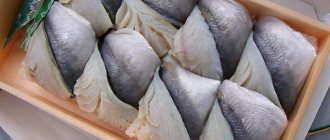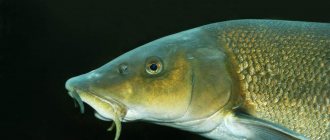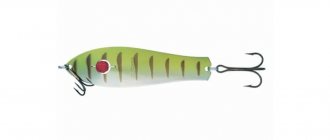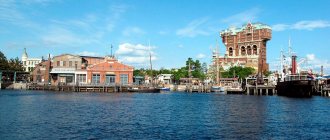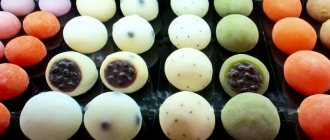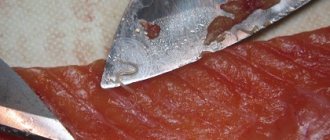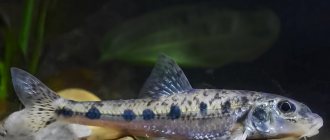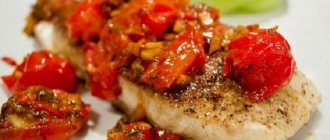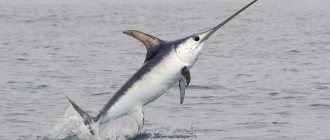Fishing in Japan
The most popular fishing in Japan is in the coastal waters of the country, the eastern coast of which is adjacent to the Pacific Ocean, and the western coast is washed by three seas: the East China, Yellow and Japan. In addition, between the Japanese islands themselves there is also the Inland Sea of Japan, or Seto-Nikai, a state reserve and, in the full sense of the word, the fishing and fish-breeding pearl of Japan. All of these seas are ice-free (except for the coast of the cold Sea of Okhotsk in northern Hokkaido), and therefore the fishing season lasts all year round.
The usual catch for fishermen in coastal waters is mackerel (mackerel). It is not for nothing that the seas of Japan are called the “kingdom of mackerels.” They are home to 40 species of this fish, including the largest king mackerel - striped (Scomberomorus corrtmersoni), found off the coast of Southern Japan and reaching 180 cm in length and weighing 50 kg.
Mackerel is caught with a simple fishing rod not only by amateurs, but also by professional fishermen. Both of them fish from boats, motor or sailing, always with bait (chopped sardine or finely chopped pieces of mackerel), which is scattered around the fishing site. Place pieces of fish and shellfish.
Flounder is also found on the sea coast.
Like mackerel, it has many species. They fish it on sandy or silt-sandy soil, at a shallow depth. The baits are sea worms, shells, and sometimes dead fish.
The greenling is widespread along the entire coast of Japan. Of its most common species, the rather large one is the one-finned one (Pleurogrammug azonue), growing up to 46 cm and reaching 1.5 kg in weight. Well, the most beautiful, perhaps, is the red greenling, found off the coast of Hokkaido. Males of this species are dark or cherry red in color, with an orange lower part of the head and a grey-blue belly. The eyes are red.
Greenlings are caught near the shore, among underwater rocks and reefs, sometimes in algae thickets. The most commonly used baits are small fish and shellfish.
One of the most interesting Japanese puffer fish (10 species) lives in numerous bays and bays of the islands of Kyushu, Shikoku and Honshu. The smallest fish, the fugu fish, is only 10 cm long, and the largest reaches 1 m. The fugu fish has a short body with a wide, rounded back and a large, thick head. These fish have an air sac extending from the stomach that can be filled with water or air. Another interesting feature of the fugu is its ability to move not only forward, but also backward (thanks to special muscles).
Japanese fishermen catch pufferfish in shallow waters near coral reefs near the shore. The fish is omnivorous and takes well on various baits. Once hooked, it tends to go into hiding and often fills its bag with water. However, most often the puffer resorts to its original “weapon” only when the angler brings it to the surface. After taking a few breaths of air, she literally turns into a ball before her eyes. However, this transformation of the puffer only plays into the hands of the anglerfish. If, when being dragged to the boat, it comes off the hook, then He can calmly and slowly take it with a landing net, since the inflated puffer will float helplessly on the surface, belly up, like a rubber ball. But if the fisherman gives her a chance, she will noisily release the air and go into the depths, trying to quickly hide in her shelter.
It is highly prized in the Japanese market, and a dish made from various types of fugu is a national delicacy. However, a fisherman, having caught fugu, is unlikely to decide to cook it himself, much less taste it, despite the high gastronomic qualities of the fish. All types of fugu are poisonous, and the effect of its poison is many times stronger than potassium cyanide. Therefore, only a cook who has completed special courses in the neutralization of this fish and received a state diploma has the right to cook fugu. Nevertheless, cases of poisoning are not uncommon in Japan, and some gourmets pay with their lives for the temptation to try fugu.
Along the eastern shores of Honshu, from its southern tip to Nagoya, yellowtails (genus Seriola) live. The most numerous is Seriola quinqueradiata, or storm in Japanese. This is a large pelagic fish, reaching 1 m in length and weighing 20-30 kg. A dish prepared from it is a necessary accessory to the Japanese festive Christmas table.
Yellowtail is of great commercial importance; it is also interesting as an object of sport fishing. Buri is a predator and bites well on live fish (sardine, mackerel), and does not refuse pieces of fish attached to a hook. Japanese fishermen also catch yellowtail using artificial bait.
The coveted catch of fishermen on the southern coast of Japan is kandai. This heat-loving species lives on the coast of the East China Sea. Kandai is a very strong fish and offers exceptionally stubborn resistance when fished. The weight of individual catching specimens is up to 10 kg.
Place number 4. Aji fish
The Japanese prefer to use aji fish to make oshizushi or sushi, where rice is mixed with vinegar and fish. In addition, fried fish is served hot.
“Some kind of reaction to a nut”: Regina Todorenko spent Valentine’s Day in the hospital
You can sow seedlings in February: but only at the end of the month (4 crops)
How names are chosen for royal children: principles are gradually changing
Who is caught and how?
The most popular catch for local fishermen is mackerel (in our country this fish is called mackerel), which is very easy to catch even in coastal waters. In total there are more than forty varieties of this fish. The largest individuals are more than 1.5 meters long and weigh about 50 kilograms!
You can catch mackerel with a fishing rod; just feed the area with a sardine and wait patiently. There will definitely be a catch, especially if the place is “fishy”.
In the coastal zone, flounder is also caught, which is fed with earthworms. This fish is great for many dishes, which makes it extremely popular and in demand. However, it is quite cheap.
Carps are not fished in Japan as they are considered sacred animals. They are bred solely for decorative purposes. However, if you still really want to catch carp, then here is a link to the site.
If we talk about truly interesting inhabitants of coastal waters, then the puffer fish stands apart. The smallest specimens of this marine fish are 10 centimeters long, and the largest are about 1 meter.
A special feature of the fish is the sac located in the stomach area, which can fill with water or air and seriously increase its size. Fugu is omnivorous and bites well on almost any bait. After the fisherman takes it to the surface, air enters the bag and the pufferfish turns into a ball.
But the information described above is not the most important thing. The point is that the fishermen themselves never cook fugu. Why, you ask? The answer is simple - the fish is terribly poisonous. Its poison is ten times stronger than potassium cyanide. Consequently, if you make a mistake when preparing fish, the person will die instantly after trying it.
The preparation of fugu is carried out exclusively by chefs who have completed special courses and received a state diploma.
Traveler's Encyclopedia
The Sea of Japan is characterized by a huge abundance of grasses and algae.
In Peter the Great Bay alone, there are more than 200 species of them. These are mainly seaweed and kelp. Sea kale is used for food purposes, which is why it is not only collected in natural areas, but also grown on special plantations. The higher types of herbs include phyllospadix and zoster, which are also numerous in these waters. The fauna is also very diverse. So, in addition to seals and whales, the Primorsky Territory is home to many species of birds.
The most numerous inhabitants of the Sea of Japan:
Sea anemones
Experienced scuba divers have a wonderful opportunity to admire sea anemones . These are primitive living creatures, close relatives of corals.
Ascidia
While observing the underwater landscape of the bays, you can often see sea squirts . Their height is 25 cm.
Shrimps
Sea cucumbers
Primorsky Krai is famous for its large number of sea cucumbers. There are many of these animals in the Far East and Southeast Asia. They are often called sea ginseng. The habitat of sea cucumbers is rocky placers, boulders and zoster thickets. They feed on microscopic organisms that live on soil particles. Scientists have discovered that the biological active substances secreted by sea cucumbers have antimicrobial and pharmacological effects. Japanese Cucumaria is very similar to sea cucumber. It lives in all Far Eastern seas, but at greater depths than the latter.
Starfish and sea urchins
Inhabitants of the Sea of Japan
Oysters, mussels and other shellfish
Kamchatka crab
Kamchatka crab
Another common inhabitant of the local waters is the Kamchatka crab. It can be found from the Korean Peninsula to the Bering Strait, as well as along the American coast at depths of up to 270m. The span of its claws reaches 150 cm. Kamchatka crab is especially numerous off the coast of Western Kamchatka, where its main fishery is concentrated. The crab feeds mainly on various small mollusks, crustaceans, and worms. In spring, schools of king crab approach the shores to breed.
Cephalopods
There is active fishing for octopus and squid in the Sea of Japan. One of the largest species of cephalopods, the giant octopus, is also found here. An adult weighs about 50 kg and reaches 3 meters in length (including tentacles). Giant octopuses live mainly in underwater grottoes, under rocks. They can also be found among piles of stones. Small specimens are found in the empty shells of large mussels. Octopuses feed on fish, shellfish, and crabs. In case of danger, the octopus releases ink liquid for camouflage and changes its color. They are often encountered by divers. Octopuses can stick to a suit or to the skin of a scuba diver with their suction cups on their tentacles, but they do not cause much harm to humans.
Fishes of the Sea of Japan
The Primorsky region is famous for its rich variety of fish. About 900 species of fish live in the Sea of Japan. Of these, 179 species are commercially available. The permanent inhabitants of these waters are pollock, Far Eastern salmon, cod, flounder, navaga, sea chanterelles, and sculpin gobies. In summer, off the coast of Primorye you can find warm-water fish such as mackerel, herring, saury, anchovy, garfish, and half-snout. Quite exotic species also swim into the Sea of Japan. For example: swordfish, sunfish, pufferfish, saberfish, flying fish, hammerhead shark, red barracuda and hedgehogfish. Among the permanent inhabitants of seaside waters there are also interesting-looking fish. Seahorses, pipefish, various mollusks, butterfly fish, and sea cockerels swim in the coastal thickets. At the bottom of the sea live bright chanterelles - agonomala, golden ruffs. There are 12 species of sharks living in the Sea of Japan, the most common of which is the Katran shark. The sharks here are not big and are not dangerous to humans.
Jellyfish
Jellyfish have long been used as a food item in Thailand, Japan, Korea, Malaysia, Indonesia and the Philippines. Ropilema jellyfish is considered one of the most valuable delicacies. However, to prepare it, you need to spend a lot of time (about a month) and effort. In addition, in China, jellyfish are used in medicine (in the treatment of tracheitis and changes in blood pressure).
Random entries
This review about the Review will be large, and perhaps not the most interesting, but I think it’s quite beautiful. And it will be about greens and flowers.
The Balkans in general and Bulgaria in particular are generally quite green areas. And the pastoral views here are gorgeous. But in the city of Obzor, greenery is mainly in parks, although there are also vegetable gardens, as you will see in the middle of this report. And finally, a little about the wildlife in and around the city.
At the entrance to the city from Varna, there is a gorgeous flowerbed, which is very difficult to see while walking. But on foot it turns out that “Overview” is written there in flowers, and in some stylized Slavic font.
Tri-City Park is located in Placencia Township, bordering Fullerton and Brea Township. All these settlements are part of Orange County, in southern California. For all the time we've been here, we haven't figured out where one city ends and another begins. And, probably, it’s not that important. They are not very different in architecture and their history is approximately the same, and parks are within easy reach. We also went to this one on foot.
After describing the hotel, as promised, I’ll tell you about the beach and the sea. Our hotel, as the name suggests, had its own beach. Well, a little bit not our own, but one huge one for three or four hotels. But sun loungers and umbrellas are free, the sea and sand are clean. The beach opens at 9 am. Closes at 6 pm.
The sun in May is already quite harsh. You get burned pretty quickly. But the sea is still pleasant - warm, but not hot. In general, swimming is good. By the way, there were no jellyfish either - I don’t know when their season is there.
This year, September 1st fell on a Sunday, adding another day to the holidays. So we decided to celebrate this day in a special way with our grandchildren. In the morning, after breakfast, I suggested going to the mountains: to Medeo or Koktyube. But to my surprise, I received a categorical refusal of two votes. Polina motivated the refusal by saying that she did not have a blouse and it was cold in the mountains. I said I would find her something warm. But she declared, purely as a woman, that she would not go in anything. Maxim simply remained silent and looked at the computer monitor. I was simply in shock, remembering my childhood, when any walk with my parents that promised some kind of entertainment, or at least ice cream, was a holiday for us. Yeah, today's kids have too much entertainment. I can’t say that I was offended, but some kind of sediment remained in my soul. I was about to go to the kitchen to put the chicken in the oven, when Maxim finally said: “Actually, we can go.” True, it was around lunchtime, it was warm outside and you could go without a blouse, so Polina quickly agreed. Before anyone changed their mind, we got ready in five minutes. There was no point in going far anymore, so we headed to Koktyube.
This summer, my husband and I made another trip - to Georgia. It turns out that he dreamed of visiting there since childhood and carefully hid it, lying on the couch and watching TV programs about travel. True, I completely understand him when, due to his duty, he has to roam the endless expanses of Kazakhstan, live not always in comfortable conditions, or rather, always in uncomfortable conditions, and on top of that, do work. Having returned home and stretched out on the sofa, you don’t really want to pack your bags and go somewhere to look at ancient ruins or outlandish places. We saw a lot here too that perhaps those who travel abroad have not seen. But when you retire, you have free time and completely different thoughts, you remember your childhood dreams. And if today you don’t turn them into reality, then tomorrow you may not have time, time is no longer working for us.
Finally, in the spring of 1949, the day came when the last scaffolding was removed. The creators of the architectural ensemble once again walked around and carefully examined the entire structure. All the shortcomings they noticed were corrected in the short period of time that remained until the day of official delivery. The selection committee, along with Soviet architects and artists, included several leading comrades from SVAG.
We have a few days left before leaving home and we have already seen enough cities, towns and even villages. But there was one more city left, significant for Saxony-Anhalt, Halle (this is more familiar to me, well, I studied even “before historical materialism,” or rather, under it, when all toponymy on maps was written in Russian transcription. And I studied in Faculty of Geography, and this toponymy, or as we called it - map nomenclature, we took weekly and with passion. So, for me, these objects are still listed as Halle and Harz, period).
I’ll tell you a little about the hotel in Sharjah. We chose an inexpensive hotel with its own beach. And in general, we liked everything, except for the lack of alcohol, but this is of course not the hotel’s problem, but the problem of the Emirate of Sharjah as a whole.
The hotel is called quite banally - Beach Hotel Sharjah. Upon check-in, we were very happily informed that they had made a free upgrade and instead of “city view” they gave us “sea view”. To be honest, I prefer to look at the city than at the sea - it’s just more interesting, but we didn’t have to choose. And as it turned out, the sea was still not visible from our room, but at the same time we had our own separate access to the pool - this is very convenient.
All rooms, which supposedly overlook the sea, have a balcony, which is very convenient in principle. And those who live on the first floor have a balcony with access to the pool.
Japan and the Russian Federation.
Although the reservoir belongs to the ocean basin, it is well isolated from it. This affects both the salinity of the Sea of Japan and its fauna. The overall balance of water is regulated by outflows and inflows through straits. It practically does not participate in water exchange (small contribution: 1%).
It is connected to other bodies of water and the Pacific Ocean by 4 straits (Tsushima, Soyu, Mamaia, Tsugaru). is about 1062 km 2. The average depth of the Sea of Japan is 1753 m, the greatest is 3742 m. It is difficult to freeze, only its northern part is covered with ice in winter.
The hydronym is generally accepted, but is disputed by the Korean powers. They claim that the name was literally imposed by the Japanese side on the whole world. In South Korea it is called the East Sea, while North Korea uses the name Korean East Sea.
The problems of the Sea of Japan are directly related to ecology. They could be called typical, if not for the fact that the reservoir washes several states at once. They have different policies on the sea, so the influence from people also varies. Among the main problems are the following:
- industrial mining;
- release of radioactive substances and petroleum products;
- oil spills.
Fish of the Far East: which families are of commercial importance
This is a region washed by the waters of the Pacific Basin. The world's largest stocks of commercial salmon and cod fish are concentrated here. The economic fishing zone affects the adjacent Pacific Seas (Bering, Japan and Okhotsk).
Many salmon species of the Far East are migratory, periodically migrating to rivers and lakes, where they can also be caught.
The names of fish in the Far East are primarily associated with salmonids, such as chum salmon, trout, salmon and others. And it is not surprising, since these species are considered to be the elite of the fishing industry.
Below are descriptions and photos of fish from the Far East that are of commercial importance. The complete list of aquatic organisms in this region is too huge and includes more than 2,000 thousand species. In addition to representatives of the ichthyofauna, this includes invertebrates and mammals (seals, fur seals and others).
Kajiki - striped marlin and swordfish
Kajiki , or kajiki maguro , is a general term referring to a group of fish; the most important of these are ma-kajiki (striped marlin) and me-kajiki (swordfish). All of them have a long sword-shaped outgrowth on the front of the head, and a large fin on the back. These fish are found in subtropical and tropical seas, they can be up to 3-5 meters in length, and the weight of some specimens exceeds half a ton.
Aroma and taste
Kajiki's taste and firm flesh are reminiscent of tuna. The best of them is considered ma-kajiki with light pink meat.
Marlin. Use in cooking
Kajiki are used to prepare dishes that require cooking, but they are also suitable for dishes such as sashimi or teriyaki .
Red salmon
Sockeye salmon (Oncorhynchus nerka) is known for the excellent taste of its meat. However, in the Russian Far East this species is found much less frequently than chum salmon and coho salmon.
Popularly, sockeye salmon is otherwise called red fish due to the corresponding color of its body. However, Oncorhynchus nerka acquires such an appearance only during the spawning period, when it migrates to rivers. This time is accompanied by the following morphological changes:
Oceanic sockeye salmon has an elongated body, cylindrical in cross-section. The dorsal side of these fish is dark gray, and the rest of the integument is painted silver-white. The scales are small, but clearly visible.
A distinctive feature of sockeye salmon from other representatives of the genus Oncorhynchus is the special color of the meat (bright red, not pink).
Fishing in Peter the Great Bay
In this water area, navaga, herring, smelt, and several types of flounder are successfully caught. Some fishermen can boast of catching Japanese mackerel, pelengas, and goby.
The toothy smelt is the most popular among fishermen. She is small in weight and height. Its main habitat is coastal waters, especially in winter.
In the middle and end of summer, due to the strong warming of the water, the fish moves deeper, returning back in mid-autumn.
In the summer, catfish can be caught with a line from the shore, boat or pier. There are many varieties of this type of fish.
Adzi - fish from hake to horse mackerel
This name unites over 50 species of fish, from hake to mackerel, which in the West can often be seen on the shelves of good fish stores. Aji in length , but usually young specimens 10-20 cm long are caught in fishermen's nets. The exception is shima-adzi , which grows up to 1 m.
Aji is considered a high quality fish and is usually reserved for sashimi. As a rule, aji is gray in color, and on both sides there are a number of pointed scales resembling saw teeth; these scales must be removed to avoid injury. The adzi fishing season lasts from spring to autumn.
Hake and horse mackerel. Application in Japanese cooking
Very fresh aji is used to prepare tataki - finely chopped fish with soy sauce and grated fresh ginger root. Aji is also fried on the grill and in a frying pan, stewed and marinated. Smaller specimens are good to fry whole. Dry fish products made from aji are also popular, such as hiraki-boshi (whole fish, gutted and dried), mirin-boshi and kusaya .
Sime-saba (salted and marinated mackerel)
Cut fresh mackerel into fillets with skin. Place both fillets on a large, flat plate covered with a thick layer of salt and cover them completely with salt.
Leave for at least half an hour, and preferably 3-4 hours.
Rinse the fillets and pat dry with paper towels, then remove any bones (you can use tweezers if desired).
Pour 120 ml of rice vinegar into a flat dish, place the fish fillets skin side up in it and sprinkle them with vinegar. Leave for 10 minutes, then drain the vinegar.
Dry the fish and carefully remove the transparent skin from the head to the tail with your fingers to preserve the silvery pattern. For sashimi, cut the fillet crosswise into thick slices 1-2 cm wide.
Hirama
This is one of the most commonly used types of fish in Japanese cooking: hirame is fried, steamed and stewed, salads and vegetable dishes with vinegar are prepared with it, as well as sushi and sashimi . Hirame is a genus of sole, a flat fish with eyes located on its back. The back of the hirame is shiny black, and the belly is matte white. The thin, wide, chain-like fins that line the sides of this fish, called engawa, are considered a delicacy; They are used for sashimi, grilled and stewed.
How to cut flat fish:
Place the fish on a cutting board and use a sharp knife to make cuts: in the middle (to the bone) and on the sides, under the fins.
Inserting the blade horizontally between the meat and the ridge, gently run the tip of the blade along the ridge, separating the meat from the bones. At the same time, carefully pull the edge of the fillet back.
Using the same method, separate the three remaining fillets: one more from the top and two from the bottom of the fish.
Place the fillet on a cutting board, skin side down, and insert the blade of a knife between the meat and the skin. Press the skin firmly against the cutting board with your fingers and run a knife from the tail to the front of the fillet, separating the skin from the meat. Using the same method, remove the skin from the remaining three fillets.
Tai - sea bream
Sea bream meat is milky white and breaks down into flakes when cooked, which is why it is used to make soboro (fish flakes). It is also used to prepare sashimi and sushi , such as oshizushi (pressed sushi), as well as soups and rice dishes. Sea bream, or tai , is a fish for holiday dishes. The length of tai can reach 1 m, but specimens 30-50 cm long are fried whole.
For especially special occasions, the fish is skewered so that it appears alive, trembling, bravely overcoming stormy waters. Red tai is reddish-silver in color and turns red when fried, and the color red is considered a symbol of celebration and joy in Japan .
How to cut round fish:
Clean the fish from scales and entrails, cut off the head. Rinse the carcass under running water, dry with a paper towel and place on a cutting board.
Insert the blade of a sharp knife close to the spinal bone of the fish and make a cut along the spine, from head to tail, keeping the knife parallel to the spinal bone.
Turn the fish over on the other side and cut the second fillet as described above.
Place one fillet on a cutting board, skin side down, and insert the blade of a knife between the skin and the meat near the tail. Press the skin against the board with your fingers and run the blade from the tail to the head, separating the skin. Do the same with the other fillet.
Anko - monkfish
For Japanese cooks, anko (monkfish), along with fugu and pufferfish, is a symbol of winter.
Angler. Application in Japanese cuisine
Monkfish is a popular fish. It is used for preparing dishes directly on the table, both in restaurants and at home. The dense, lumpy meat of monkfish, which does not break up into flakes even when boiled, is perfect for frying and stewing. All parts of this fish are eaten, including caviar, liver and stomach. The liver, usually marinated in a vinegar sauce, is considered a delicacy and is often compared to foie gras. You can check how true the comparison is if you look at some fishmonger, buy special gear for catching anko there, catch fresh devils, cook according to all the rules and compare. Monkfish are found in many seas, by the way. And in the Black Sea, for example, there is also.
Red fish of the Far East
This term is usually used to refer to delicious representatives of the sturgeon family. However, in common parlance it is also applied to some species of salmon living in the Far East. Fishes of this group are distinguished by the characteristic color of their meat, which can be pink or red-pink. However, not all inhabitants of the depths have this trait.
Among the fish of the Far East, the name “red” is used in relation to the following species:
Initially it was used to mean the quality of the meat, not its color, and was applied only to sturgeon. However, later the name was assigned to salmonids. In the Far East, fish belonging to this family are a key fishery object.
Karey - flounder - halibut
This is the name of a family that includes more than a hundred species of fish. Externally, the karei are very similar to the hirame (see below), but the brown eyes are located on the right side of the body, and the hirame on the left; In addition, brownies have smaller mouths. The structure and taste of meat of different types of curry can be very different. The best fish in this family is considered to be flounder with dense, tender and remarkably tasty meat, but not everyone recognizes its primacy. Some prefer halibut for its excellent meaty texture.
It is usually sold whole, although larger specimens may be sold cut into steaks or fillets. The meat of the sole is more loose, and the taste is not so pronounced. The curry season begins at different times, depending on the specific type of fish. The most desirable prey for fishermen is brown fish, ready for spawning. Karei is a universal fish ; they can be fried in a frying pan and on the grill, stewed, and also made into sashimi.
Suzuki - sea bass
The pinkish-white meat of sea bass has a delicate flavor and lumpy texture, which gives sashimi and sushi a pleasant freshness. Sea bass reaches a length of 1 m. Specimens longer than 50 cm are tastier than small ones. It is a beautiful fish with large round eyes, a bluish-gray back and a silvery-white belly.
Sea bass should only be lightly boiled: with sauce, in soup, in stew or steamed. It is not suitable for frying, as its meat is too tender. Sea bass is available all year round, whole or filleted. But it tastes best in spring and early summer, before spawning. Wild perch tastes better than farmed perch.
